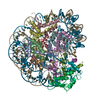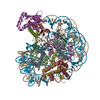[English] 日本語
 Yorodumi
Yorodumi- PDB-8grq: Cryo-EM structure of BRCA1/BARD1 bound to H2AK127-UbcH5c-Ub nucleosome -
+ Open data
Open data
- Basic information
Basic information
| Entry | Database: PDB / ID: 8grq | |||||||||||||||||||||||||||||||||||||||||||||
|---|---|---|---|---|---|---|---|---|---|---|---|---|---|---|---|---|---|---|---|---|---|---|---|---|---|---|---|---|---|---|---|---|---|---|---|---|---|---|---|---|---|---|---|---|---|---|
| Title | Cryo-EM structure of BRCA1/BARD1 bound to H2AK127-UbcH5c-Ub nucleosome | |||||||||||||||||||||||||||||||||||||||||||||
 Components Components |
| |||||||||||||||||||||||||||||||||||||||||||||
 Keywords Keywords | NUCLEAR PROTEIN / nucleosome / BRCA1/BARD1 / BRCA1 / BARD1 / H2AK127 / H2AK127-UbcH5c-Ub | |||||||||||||||||||||||||||||||||||||||||||||
| Function / homology |  Function and homology information Function and homology informationnegative regulation of mRNA 3'-end processing / Deposition of new CENPA-containing nucleosomes at the centromere / Inhibition of DNA recombination at telomere / DNA Damage/Telomere Stress Induced Senescence / Regulation of endogenous retroelements by KRAB-ZFP proteins / Condensation of Prophase Chromosomes / histone H2AK127 ubiquitin ligase activity / histone H2AK129 ubiquitin ligase activity / Defective DNA double strand break response due to BRCA1 loss of function / Defective DNA double strand break response due to BARD1 loss of function ...negative regulation of mRNA 3'-end processing / Deposition of new CENPA-containing nucleosomes at the centromere / Inhibition of DNA recombination at telomere / DNA Damage/Telomere Stress Induced Senescence / Regulation of endogenous retroelements by KRAB-ZFP proteins / Condensation of Prophase Chromosomes / histone H2AK127 ubiquitin ligase activity / histone H2AK129 ubiquitin ligase activity / Defective DNA double strand break response due to BRCA1 loss of function / Defective DNA double strand break response due to BARD1 loss of function / Recognition and association of DNA glycosylase with site containing an affected purine / Metalloprotease DUBs / BRCA1-BARD1 complex / Cleavage of the damaged purine / HDACs deacetylate histones / PRC2 methylates histones and DNA / UCH proteinases / BRCA1-B complex / BRCA1-A complex / BRCA1-C complex / MLL4 and MLL3 complexes regulate expression of PPARG target genes in adipogenesis and hepatic steatosis / negative regulation of centriole replication / sex-chromosome dosage compensation / RUNX1 regulates genes involved in megakaryocyte differentiation and platelet function / random inactivation of X chromosome / polytene chromosome / RMTs methylate histone arginines / ubiquitin-modified histone reader activity / chordate embryonic development / cellular response to indole-3-methanol / gamma-tubulin ring complex / negative regulation of intracellular estrogen receptor signaling pathway / nuclear ubiquitin ligase complex / DNA strand resection involved in replication fork processing / homologous recombination / negative regulation of fatty acid biosynthetic process / Regulation of MITF-M-dependent genes involved in DNA replication, damage repair and senescence / tissue homeostasis / protein K6-linked ubiquitination / regulation of phosphorylation / Ub-specific processing proteases / lateral element / regulation of DNA damage checkpoint / Impaired BRCA2 binding to PALB2 / XY body / mitotic G2/M transition checkpoint / negative regulation of protein export from nucleus / RNA polymerase binding / DNA repair complex / DNA damage tolerance / centrosome cycle / Homologous DNA Pairing and Strand Exchange / Defective homologous recombination repair (HRR) due to BRCA1 loss of function / Defective HDR through Homologous Recombination Repair (HRR) due to PALB2 loss of BRCA1 binding function / Defective HDR through Homologous Recombination Repair (HRR) due to PALB2 loss of BRCA2/RAD51/RAD51C binding function / Resolution of D-loop Structures through Synthesis-Dependent Strand Annealing (SDSA) / intracellular membraneless organelle / Resolution of D-loop Structures through Holliday Junction Intermediates / HDR through Single Strand Annealing (SSA) / negative regulation of gene expression via chromosomal CpG island methylation / response to ionizing radiation / Impaired BRCA2 binding to RAD51 / Transcriptional Regulation by E2F6 / mitotic G2 DNA damage checkpoint signaling / negative regulation of cell cycle / negative regulation of reactive oxygen species metabolic process / Presynaptic phase of homologous DNA pairing and strand exchange / positive regulation of vascular endothelial growth factor production / ubiquitin ligase complex / SUMOylation of DNA damage response and repair proteins / regulation of DNA repair / negative regulation of extrinsic apoptotic signaling pathway via death domain receptors / protein autoubiquitination / tubulin binding / Meiotic synapsis / positive regulation of DNA repair / cellular response to ionizing radiation / male germ cell nucleus / TP53 Regulates Transcription of DNA Repair Genes / chromosome segregation / Nonhomologous End-Joining (NHEJ) / double-strand break repair via homologous recombination / negative regulation of cell growth / G2/M DNA damage checkpoint / RING-type E3 ubiquitin transferase / HDR through Homologous Recombination (HRR) / Meiotic recombination / kinase binding / Metalloprotease DUBs / intrinsic apoptotic signaling pathway in response to DNA damage / cytoplasmic ribonucleoprotein granule / positive regulation of angiogenesis / ubiquitin-protein transferase activity / fatty acid biosynthetic process / positive regulation of protein catabolic process / p53 binding / structural constituent of chromatin / cellular response to tumor necrosis factor / UCH proteinases / KEAP1-NFE2L2 pathway Similarity search - Function | |||||||||||||||||||||||||||||||||||||||||||||
| Biological species |  Homo sapiens (human) Homo sapiens (human) | |||||||||||||||||||||||||||||||||||||||||||||
| Method | ELECTRON MICROSCOPY / single particle reconstruction / cryo EM / Resolution: 3.87 Å | |||||||||||||||||||||||||||||||||||||||||||||
 Authors Authors | Ai, H.S. / Zebin, T. / Zhiheng, D. / Jiakun, T. / Liying, Z. / Jia-Bin, L. / Man, P. / Liu, L. | |||||||||||||||||||||||||||||||||||||||||||||
| Funding support |  China, 1items China, 1items
| |||||||||||||||||||||||||||||||||||||||||||||
 Citation Citation |  Journal: Chem / Year: 2023 Journal: Chem / Year: 2023Title: Synthetic E2-Ub-nucleosome conjugates for studying nucleosome ubiquitination. Authors: Ai, H.S. / Tong, Z. / Deng, Z. / Tian, J. / Zhang, L. / Sun, M. / Du, Y. / Xu, Z. / Shi, Q. / Liang, L. / Zheng, Q. / Li, J.B. / Pan, M. / Liu, L. | |||||||||||||||||||||||||||||||||||||||||||||
| History |
|
- Structure visualization
Structure visualization
| Structure viewer | Molecule:  Molmil Molmil Jmol/JSmol Jmol/JSmol |
|---|
- Downloads & links
Downloads & links
- Download
Download
| PDBx/mmCIF format |  8grq.cif.gz 8grq.cif.gz | 353.9 KB | Display |  PDBx/mmCIF format PDBx/mmCIF format |
|---|---|---|---|---|
| PDB format |  pdb8grq.ent.gz pdb8grq.ent.gz | 266.5 KB | Display |  PDB format PDB format |
| PDBx/mmJSON format |  8grq.json.gz 8grq.json.gz | Tree view |  PDBx/mmJSON format PDBx/mmJSON format | |
| Others |  Other downloads Other downloads |
-Validation report
| Summary document |  8grq_validation.pdf.gz 8grq_validation.pdf.gz | 1.4 MB | Display |  wwPDB validaton report wwPDB validaton report |
|---|---|---|---|---|
| Full document |  8grq_full_validation.pdf.gz 8grq_full_validation.pdf.gz | 1.4 MB | Display | |
| Data in XML |  8grq_validation.xml.gz 8grq_validation.xml.gz | 46 KB | Display | |
| Data in CIF |  8grq_validation.cif.gz 8grq_validation.cif.gz | 72.6 KB | Display | |
| Arichive directory |  https://data.pdbj.org/pub/pdb/validation_reports/gr/8grq https://data.pdbj.org/pub/pdb/validation_reports/gr/8grq ftp://data.pdbj.org/pub/pdb/validation_reports/gr/8grq ftp://data.pdbj.org/pub/pdb/validation_reports/gr/8grq | HTTPS FTP |
-Related structure data
| Related structure data |  34212MC  8grmC M: map data used to model this data C: citing same article ( |
|---|---|
| Similar structure data | Similarity search - Function & homology  F&H Search F&H Search |
- Links
Links
- Assembly
Assembly
| Deposited unit | 
|
|---|---|
| 1 |
|
- Components
Components
-Protein , 7 types, 11 molecules AEBFCGDHKMN
| #1: Protein | Mass: 11530.447 Da / Num. of mol.: 2 Source method: isolated from a genetically manipulated source Source: (gene. exp.)  Homo sapiens (human) / Gene: CALMAC_LOCUS17614 / Production host: Homo sapiens (human) / Gene: CALMAC_LOCUS17614 / Production host:  #2: Protein | Mass: 9123.692 Da / Num. of mol.: 2 Source method: isolated from a genetically manipulated source Source: (gene. exp.)  Homo sapiens (human) / Gene: Dana\GF27365, Dana_GF27365, GF27365 / Production host: Homo sapiens (human) / Gene: Dana\GF27365, Dana_GF27365, GF27365 / Production host:  #3: Protein | Mass: 12066.128 Da / Num. of mol.: 2 Source method: isolated from a genetically manipulated source Source: (gene. exp.)  Homo sapiens (human) / Gene: H2ac12, Hist1h2ah / Production host: Homo sapiens (human) / Gene: H2ac12, Hist1h2ah / Production host:  #4: Protein | Mass: 20937.998 Da / Num. of mol.: 2 Source method: isolated from a genetically manipulated source Source: (gene. exp.)  Homo sapiens (human) / Production host: Homo sapiens (human) / Production host:  #7: Protein | | Mass: 10626.693 Da / Num. of mol.: 1 Source method: isolated from a genetically manipulated source Source: (gene. exp.)  Homo sapiens (human) / Gene: BRCA1, RNF53 / Production host: Homo sapiens (human) / Gene: BRCA1, RNF53 / Production host:  References: UniProt: P38398, RING-type E3 ubiquitin transferase #8: Protein | | Mass: 10348.078 Da / Num. of mol.: 1 Source method: isolated from a genetically manipulated source Source: (gene. exp.)  Homo sapiens (human) / Gene: BARD1 / Production host: Homo sapiens (human) / Gene: BARD1 / Production host:  References: UniProt: Q99728, RING-type E3 ubiquitin transferase #9: Protein | | Mass: 16657.938 Da / Num. of mol.: 1 Source method: isolated from a genetically manipulated source Source: (gene. exp.)  Homo sapiens (human) / Gene: UBE2D3, hCG_2028213 / Production host: Homo sapiens (human) / Gene: UBE2D3, hCG_2028213 / Production host:  |
|---|
-DNA chain , 2 types, 2 molecules IJ
| #5: DNA chain | Mass: 45604.047 Da / Num. of mol.: 1 Source method: isolated from a genetically manipulated source Source: (gene. exp.)  Homo sapiens (human) / Production host: Homo sapiens (human) / Production host:  |
|---|---|
| #6: DNA chain | Mass: 45145.754 Da / Num. of mol.: 1 Source method: isolated from a genetically manipulated source Source: (gene. exp.)  Homo sapiens (human) / Production host: Homo sapiens (human) / Production host:  |
-Non-polymers , 1 types, 4 molecules 
| #10: Chemical | ChemComp-ZN / |
|---|
-Details
| Has ligand of interest | Y |
|---|---|
| Has protein modification | N |
-Experimental details
-Experiment
| Experiment | Method: ELECTRON MICROSCOPY |
|---|---|
| EM experiment | Aggregation state: PARTICLE / 3D reconstruction method: single particle reconstruction |
- Sample preparation
Sample preparation
| Component | Name: Complex of BRCA1/BARD1 and H2AK127-UbcH5c-Ub nucleosome Type: COMPLEX / Entity ID: #9, #1-#3, #5-#6, #4 / Source: RECOMBINANT |
|---|---|
| Source (natural) | Organism:  Homo sapiens (human) Homo sapiens (human) |
| Source (recombinant) | Organism:  |
| Buffer solution | pH: 7.5 |
| Specimen | Embedding applied: NO / Shadowing applied: NO / Staining applied: NO / Vitrification applied: YES |
| Vitrification | Cryogen name: ETHANE |
- Electron microscopy imaging
Electron microscopy imaging
| Experimental equipment |  Model: Titan Krios / Image courtesy: FEI Company |
|---|---|
| Microscopy | Model: FEI TITAN KRIOS |
| Electron gun | Electron source:  FIELD EMISSION GUN / Accelerating voltage: 300 kV / Illumination mode: FLOOD BEAM FIELD EMISSION GUN / Accelerating voltage: 300 kV / Illumination mode: FLOOD BEAM |
| Electron lens | Mode: BRIGHT FIELD / Nominal defocus max: 2500 nm / Nominal defocus min: 1000 nm |
| Image recording | Electron dose: 50 e/Å2 / Film or detector model: GATAN K3 (6k x 4k) |
- Processing
Processing
| Software | Name: PHENIX / Version: 1.19.2_4158: / Classification: refinement | ||||||||||||||||||||||||
|---|---|---|---|---|---|---|---|---|---|---|---|---|---|---|---|---|---|---|---|---|---|---|---|---|---|
| EM software | Name: PHENIX / Category: model refinement | ||||||||||||||||||||||||
| CTF correction | Type: NONE | ||||||||||||||||||||||||
| 3D reconstruction | Resolution: 3.87 Å / Resolution method: FSC 0.143 CUT-OFF / Num. of particles: 68006 / Symmetry type: POINT | ||||||||||||||||||||||||
| Refine LS restraints |
|
 Movie
Movie Controller
Controller







 PDBj
PDBj
















































